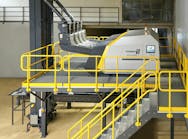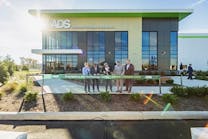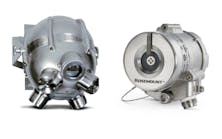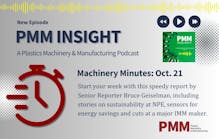From the Fall 2022 issue of Plastics Recycling.
By Ron Shinn
Totally autonomous sorting — a process that most operators of material recovery facilities (MRFs) have long considered unattainable — may be about to happen.
Can the next logical step, a completely autonomous processing system, be ahead?
A Canadian MRF operator is set to start up in the fourth quarter the first autonomous sorting line installed by Bulk Handling Systems (BHS) of Eugene, Ore. The system uses artificial intelligence to continually refine itself as plastic and other materials make multiple passes through optical sorters.
It took more than eight years to develop all the components and build the complete system.
“Our focus is to absolutely eliminate all of the people in the system with the exception of maintenance personnel,” said Thomas Brooks, BHS’ chief technical officer, who is based at the company’s technical center in Nashville, Tenn.
“We absolutely believe that this is the next big change we are going to see in recycling, just like what we saw when we introduced optical sorting and just like what we saw when we introduced robotics,” he said.
The new system takes out much of the human decision-making in terms of prioritizing what type of material to sort. It can remove five different commodities, Brooks said.
Operator sets priorities
“The operator has the ability to select on all five of those and how much of each he wants to remove from the stream,” he said. “How aggressive do you want to be? What are you trying to achieve? You have also got some flexibility around market conditions. The system then has the ability to decide which commodities to process first and how many times to send the material through the loop to extract each commodity. The system makes all those decisions.
“You end up with material going out to prescribed bunkers and a person has not touched it either physically or technically,” Brooks said.
Maximum throughput of the system is about 6.5 tons per hour. The design can easily be scaled to much higher throughputs, Brooks said.
BHS is not permitted to name the MRF operator or location except to say that it is in Canada.
This first autonomous sorting system uses temporary storage bunkers and conveyors configured in a loop to carry mixed materials several times through a single, AI-powered optical sorter and robot station. The computer can reprogram itself with each pass to pull out a different commodity until all the PP, natural HDPE, color HDPE, PET and aluminum cans have been sorted. It can also prioritize a single commodity.
Brooks said the circular layout and sophisticated control system means one optical sorter and one robot can do the work of several units. In a traditional line, which requires a bigger footprint, five optical sorters and five robots would be needed to sort out five commodities.
BHS powers system
Technology that drives the autonomous sorting system comes from several business units within the BHS group. Optical sorters, first introduced about eight years ago, are built by National Recovery Technologies (NRT), air separators and conveyors come from Nihot, and robotic sorters and vision systems are BHS Max-AI autonomous quality control (AQC) technology.
A Max-AI AQC-2 system uses a pair of delta robots arms to conduct a pre-sort. “It is pulling out the general stuff you would see going into a container line, such as large residue, textiles, the random tennis shoes and teddy bears,” Brooks said. “There is also a magnet before going into the dedicated loop that pulls out ferrous material.
“This allows the system to focus on the specific commodities,” Brooks said. “The more non-commodities we can pull out, the greater the capacity and improvement in run times and everything else because of the larger cuts you can make with every pass.”
The vision system starts analyzing the stream during the initial pre-sort. The data helps the control system decide the best way to sort the material.
After pre-sort, the material goes into a storage bunker. Once the bunker is full, the control system releases it to be conveyed to an optical sorter equipped with an AI-powered vision system and near-infrared detection system. The sorter ejects the material it is programmed to detect, then the ejected material goes through another AQC-2 dual-arm system to be placed in the bunker designed for that item.
Everything that was not ejected by the optical sorter is conveyed back to the first storage bunker. The process is repeated when the bunker is full. After several passes, it is expected that everything the control system is programmed to detect will have been ejected from the waste stream at the levels set by the plant operator.
The line requires one to two hours per day of downtime for maintenance, which includes things like cleaning the optical sorter lenses, checking light levels, checking for obstructions and general cleanliness.
Optimism for the future
Brooks said he is confident the new sorting system will operate as planned. “We’ve come a long way since we first introduced AI back in 2016 so that the systems we put in place now are performing at a relatively high level right out of the gate. We have learned so much over that time around the database creation, how we train, what we know about materials and how the AI and neural networks respond to different training techniques.”
Brooks said the installation has generated a good deal of interest from BHS customers, many of which struggle to hire and keep workers on a sorting line.
“Within the next couple of months, I am expecting to see another probably two or three of these contracts being signed and then we will be looking for those to be closed out [installed] by the end of 2023,” Brooks said.
“We are very anxious to get this first system going,” Brooks said. “We expect to learn a lot at this first location.”
Brooks said this new, patented sorting line technology is a big steppingstone and BHS is looking ahead to expanding it to a completely autonomous plastics processing system – an entire plant run by one or two maintenance people. That is a goal Brooks said he has been looking toward since 2016.
Ron Shinn, editor
Ron Shinn | Editor
Editor Ron Shinn is a co-founder of Plastics Machinery & Manufacturing and has been covering the plastics industry for more than 35 years. He leads the editorial team, directs coverage and sets the editorial calendar. He also writes features, including the Talking Points column and On the Factory Floor, and covers recycling and sustainability for PMM and Plastics Recycling.






